I feel like most of the garden has settled in to its final design and now everything just needs to grow. Except for this bed at the back. This is the one area I think still calls for serious reconsideration.
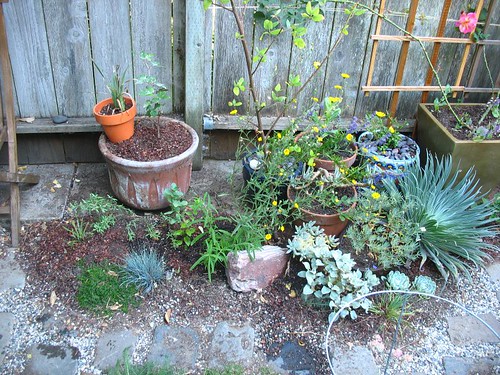
This bed first came into existence sometime last February, a month or so after I finished the cobblestone path that circles the CA native bed. It appeared on the blog for the first time in prelude in that month's disturbingly Blue post. (This post is actually kind of blue, so I'll try to keep it short.)
I've used this area to dump a lot of stuff I didn't know what else to do with. Let's examine the individual elements.
First of all, I didn't get a good picture of the Ceanothus 'Ray Hartman', but it's the tall plant belonging to the thin trunk climbing up off the top of the picture. It just doesn't seem to be doing very well. It lived in a container for several months before I planted it here, and I think it hates me for doing that. It might have to go. But I do feel that Ray Hartman belongs in this bed, and I may just replace him with a fresh specimen. So there's that.
But what else.
Well, there's this disturbingly monochromatic gray thing going on.
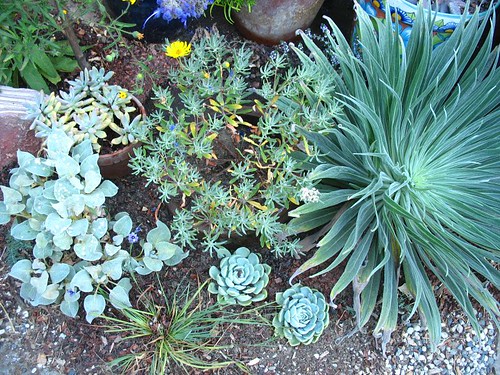
Yet another Echium wildprettii. I have four of these, ladies and gentlemen. I used to have five! There's no excuse for this situation. What can I say? I got swept up in one of my periodic flaming homosexual-themed decorating rampages.

You who garden outside of the mediterranean climate zone might not recognize this plant now for the phallic, path-obscuring monstrosity it will become next year when the inflorescence comes. (Pun intended.) Should I pull it, and enjoy three?
I have three of these too--Eriogonum arborescens (Polygonaceae). I grew this from seed. (So what, I grew the Echium from seed too.) This one doesn't look as good as the other two, but I think it'll be fine. I feel a strong desire to keep this plant based on what it brings to the garden and how it works in relation to the other two E. arborescens.
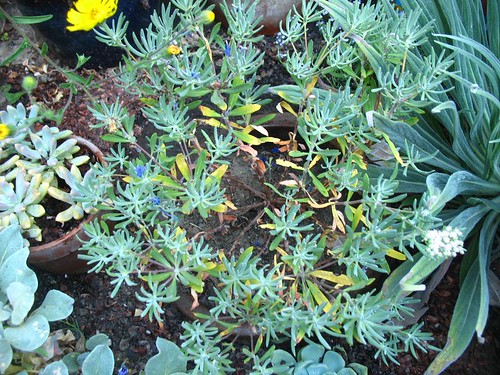
This is Eriogonum latifolium, coast buckwheat. (I think that's right; I'm kind of spacing right now.) This can stay in the garden, but it can't stay here.

I have another one right across the path, in bloom. Or post-bloom. It looks like this:
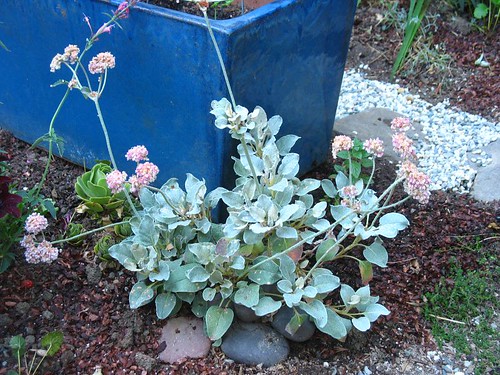
This is a good native for this area, and bees love it.
I have these succulents. These are cuttings I just stuck in the ground here; they don't need to stay at all.
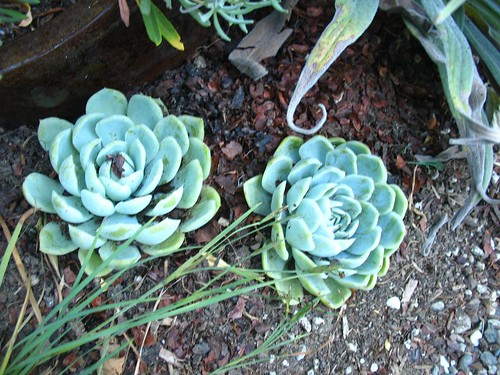
I have five more I stuck in pots.
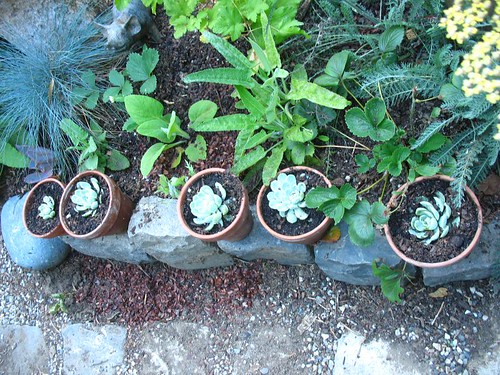
I could be happy keeping the five, and letting go of these two. Maybe I can give these two to someone else, or plant them around the community garden this fall. Or maybe they can go up on the roof.
Finally, closing out the gray zone, this succulent:

This plant is only gray right now. I wish I could remember the name of this plant, because I'd like to recommend it to you. But I have a terrible time with succulent names for some reason. Anyway, this plant goes through a range of color changes depending on water, sun exposure, and season. It's actually purple-yellow when it's happy. I don't know why it's not happy. It's probably the soil.
Anyway, this plant's in a pot and I can improve the situation with this plant by moving it about two feet over.
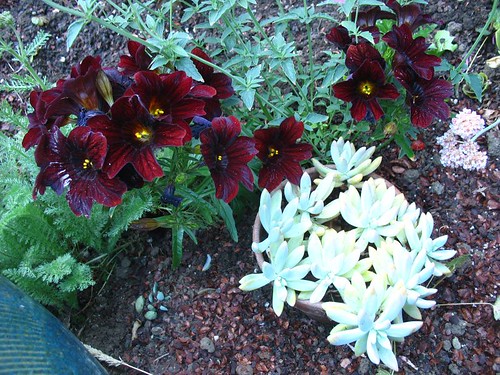
Yeah. I'll plant that in the ground tomorrow, and call it good. (That red flower--I forgot the name--is another one of the three I saw in the "paid-for" area at my nursery. The third and final plant I bought like that is this rosy pink and orange number; isn't it pretty? I think it is.)
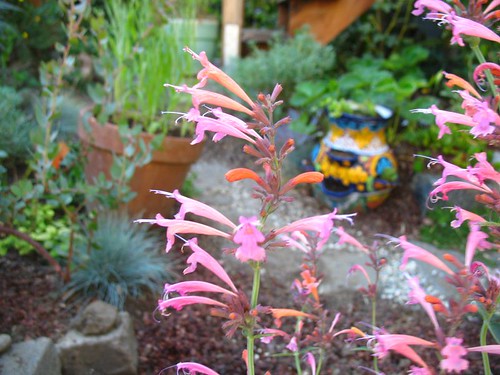
Also back here, currently my bitterest garden disappointment, Vaccinium 'Top Hat'. This is a dwarf blueberry I've had all year. It's growing in acidic azalea mix. It should be much happier than this. I'm very disappointed. Should I just give up on this plant, or wait a year?

One of the dozen Cerinthe major volunteers that came up recently. It's growing at an alarming rate, and if it keeps up I could have flowers in a couple weeks. I'm quite amazed.
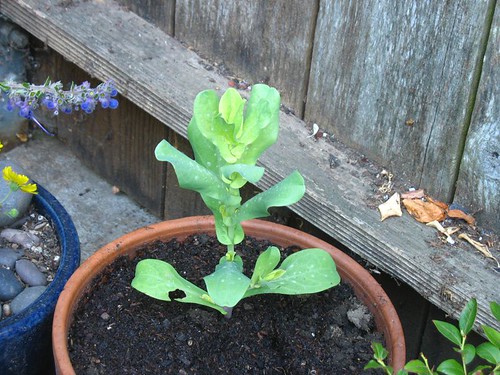
Super-fragrant and bee-beloved, this is CA native Trichostema lanatum, Wooly Blue Curls.
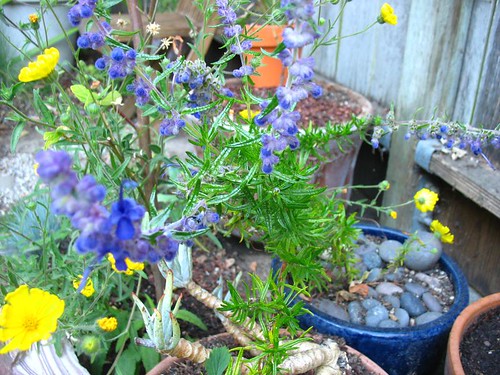
I enjoy this species but this specimen has grown weirdly and it's hard to feature. Perhaps I should prune it somehow... I'm told planting it in the ground is risky in San Francisco--but I could take that risk with this plant since it's already kind of a mess. I don't know.
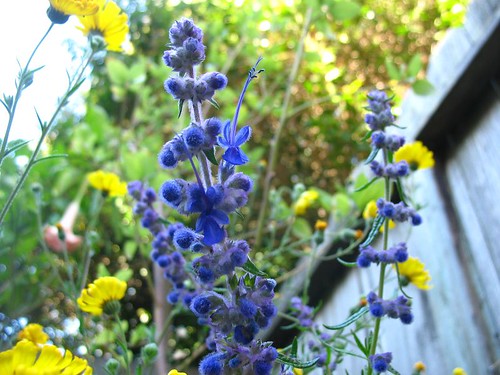
Cotyledon orbiculatum var. longifolium. I planted this cutting the last time I was stoned, whenever that was.
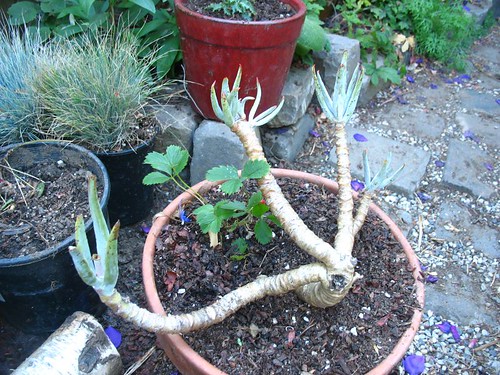
Previously, this plant was in a box on my front porch and it was growing over the box and trailing into the path of people using the front steps. So I cut it, and stuck it in this pot straight up thinking it would be groovy and unusual when it started making new growth at the tips. I never would have thought of that sober. I still think it will work out, but here I've moved it to a shady area to root. (I put the strawberry in the other day to fill up some empty space while the cutting roots.)
Yet more Cerinthe... it self-sowed vigorously. Seriously, I have about 20 of these.
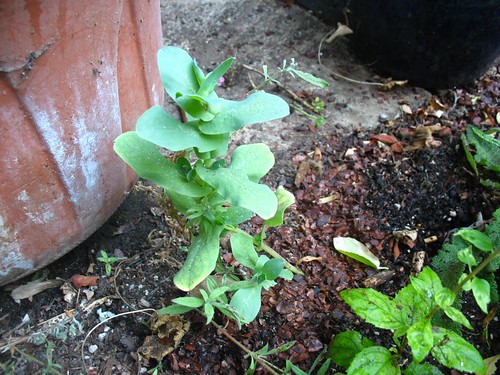
Keckiella cordifolia. I grew these for the Botanical Garden, and kept a few for myself. I have no idea what to expect from this plant.

I'm so tired of this blue grass. I have five of them from divisions.

I started sticking thyme here and there to cover all the dirt. I see no reason to remove thyme.
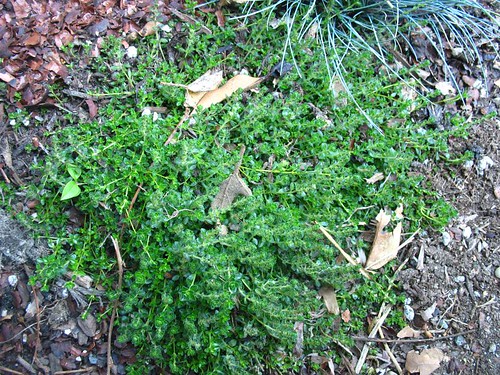
Speaking of thyme, have you read these books?
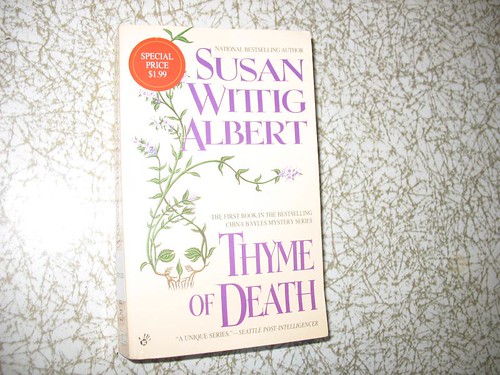
I picked it up off the sidewalk on my way to the bank after the garage sale. (Lots of people who couldn't get money for their stuff left it all out on the sidewalk for people to pick through for free.) Anyhoo, it's from a series about a former attorney who opens an herb shop in lovely Pecan Springs, Texas. Naturally, she gets drawn in to botanically inflected murder mysteries that she uses her lawyering skills to solve. What's not to love.
But this post isn't about books, it's about my problems.
Back to my problems.
I have this mangy Lessingia I recently tipped way back to encourage new growth from the base...
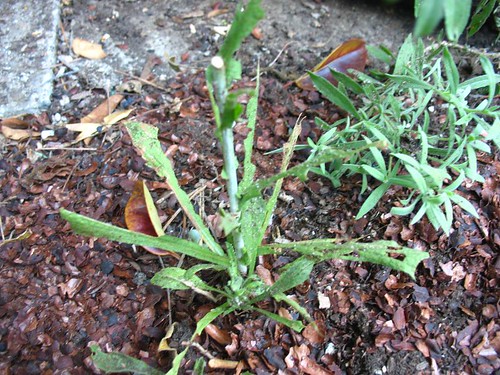
A blurry Epilobium...

And a blurry and mangy Salvia spathacea (new from seed this year).

The vine is Ampelopsis brevipedunculata which I'd heard is a fabulous plant (where it's not invasive) and I found on clearance late last year. I've had to cut this one way back because it was all enmeshed in the tomatoes I removed in the last post.
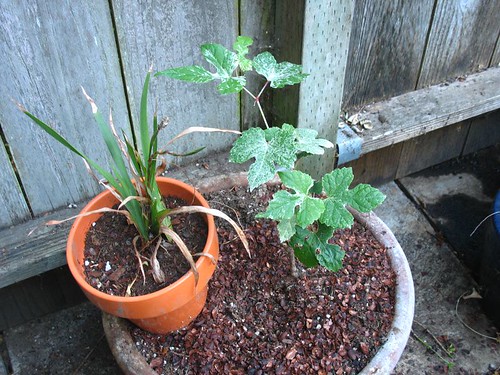
And finally, I have the annual Madia (not a problem; it's an annual) and this rock which I bought on impulse at the stoneyard one day last year. Actually, I bought three of them. I ended up giving one to my dad. Maybe I should give him the other two.
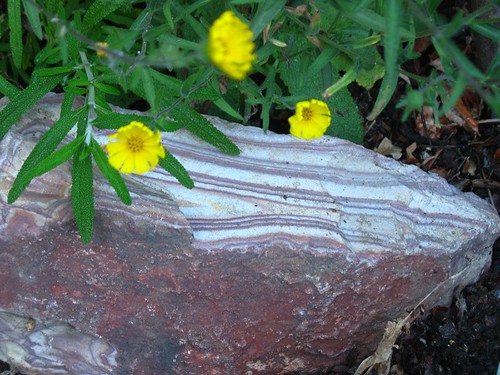
And that's where this post ends. Seriously. I hope you weren't expecting me to have this all fixed by the end of the post..? Rome wasn't built in a day, people! I have to think about this for awhile.
(I do apologize that everything is so blue. I should know better than to take pictures late in the day like this. The light is just all wrong.)

13 comments:
I have the variegated version of the Ampelopsis...I love it, but it does have a bad reputation. As for the blueberry, I'd give it another season. Does it get plenty of sun? They seem to like that best. (My soil is acid, and wild blueberries are thick around here.) I think that area could use some red or copper-color foliage of some sort...but that's as "helpful" as my comments get, cuz' I can't think of anything except 'Husker Red' penstemon.
I would take that Echium wildprettii off your hands for you if I lived in SF. Maybe even all four. I think it's absolutely gorgeous. Show us what it does when it blooms; maybe that would change my mind.
Actually, I think it's shaping up quite nicely. You may have a different perspective because you see it all the time. I really like all the greyish-green stuff, especially Echium wildprettii, what a great name!
Ditto what Pam said about the echium. Except that you'd probably be sending them to certain death here in the north. *grin* I assume that's what's in the picture that shows your 45 day old cucumber plants, too, right?
This is a complete and total stab in the dark, but could those red/brown velvety flowers be salpiglossis? I bought seeds this spring for a salpiglossis that looks similar on the seed packet... but never did start them because when I actually took the time to read the sowing instructions (what a concept) I found out it was going to be a pain in the butt. Required certain light conditions, etc. Blah.
I think you're right about Salpiglossis, Kim. It was some long, weird name that started with an 'S'. I kept the tag so I could take another look at it.
Speaking of pain in the butt seeds, I've been trying to germinate Columbine seeds; those need light too. It hasn't worked all year, even with some pre-chilling. Ever have luck with Columbine? Anyone?
Another reason I can't dig up the Echium...it grows on a taproot. Which is another reason you might like it where it's hot. It never needs any supplemental water. However, it probably isn't hardy at all.
My Ampelopsis is variegated too; tho' you might not see that in the picture. The degree of variegation varies extensively over the plant. Some leaves are totally white, some are totally green, and everything in between. And I think it changes varies on light exposure (looking less variegated in strong light), but it might be my imagination. I don't know how those little variegation viruses work. Or maybe Ampelopsis isn't variegated and it was treated with a radioisotope. Who knows.
Thanks for coming by, everyone.
Columbine comes up from seed for me really well, and I don't even chill it-just sprinkle on top the soil in March or April, and by July, there's foliage and sometimes flowers already. Maybe you're trying too hard...or birds are making off with the seeds when you aren't looking.
The echium has a taproot, huh? I'm gonna grow one of those babies in a deep pot and bring it inside when it freezes if I have to.
1. Save all the Echiums. They're monocarpic, right?
[1A. for visitors "from away": the place for Echiums is Annie's].
2. One of the first plants I killed was Vaccinum ovatum. Yours looks much happier than mine did before it died -- I'd wait and see what it does next spring.
Oh yeah, I think your mystery succulent might be a Graptopetalum. Has it flowered?
I have huckleberry and blueberry; the huckleberries look fabulous, but the blueberry... I guess I'll hold to it for another year per Lisa's advice. But it's on probation!
Also, echium seed can be had from J.L. Hudson (or me, next year) if you wanna go that way.
Yes, that's right; it's Graptopetalum paraguayense. Thanks! I'll forget again in a day or two, but I'll always know it's on the blog.
Sometimes accessing your site gets my computer churning and I have to give up temporarilly... think that's how I missed this post, Chuck- lots of cool stuff here.
I hope Pam gets the Echium going because I want to see how a path-blocking inflorescence would work in her design. Now wouldn't you think something like that would also fit into Barbara Damrosch's Pavilion/ garden of love from her Theme Gardens book?
Chuck - Susan Albert is a sort of celebrity around Central Texas, and I have some of her books, too. You could read 'Thyme of Death' for Carol/May Dreams next book club session, which is for mystery novels with a garden theme.
If I could reach through the screen there'd be a little piece of the Grapetopetalum right here.
Annie at the Transplantable Rose
code is pcokimhe
Surely you know the mnemonic:
First year, sleep
Second year, creep
Third year, leap
?
I'd look to see how those blueberries are doing next year. Should be fine.
Post a Comment